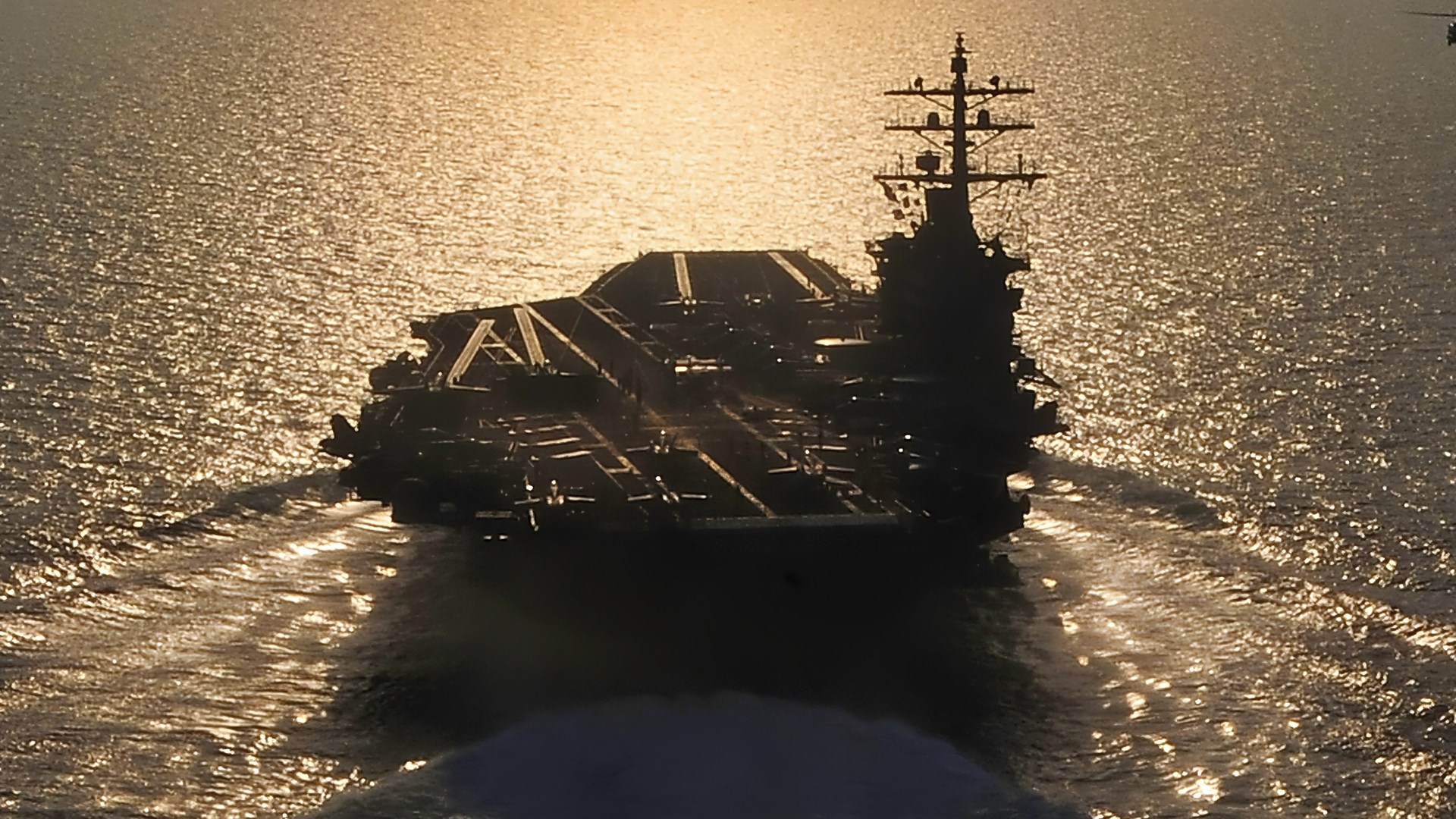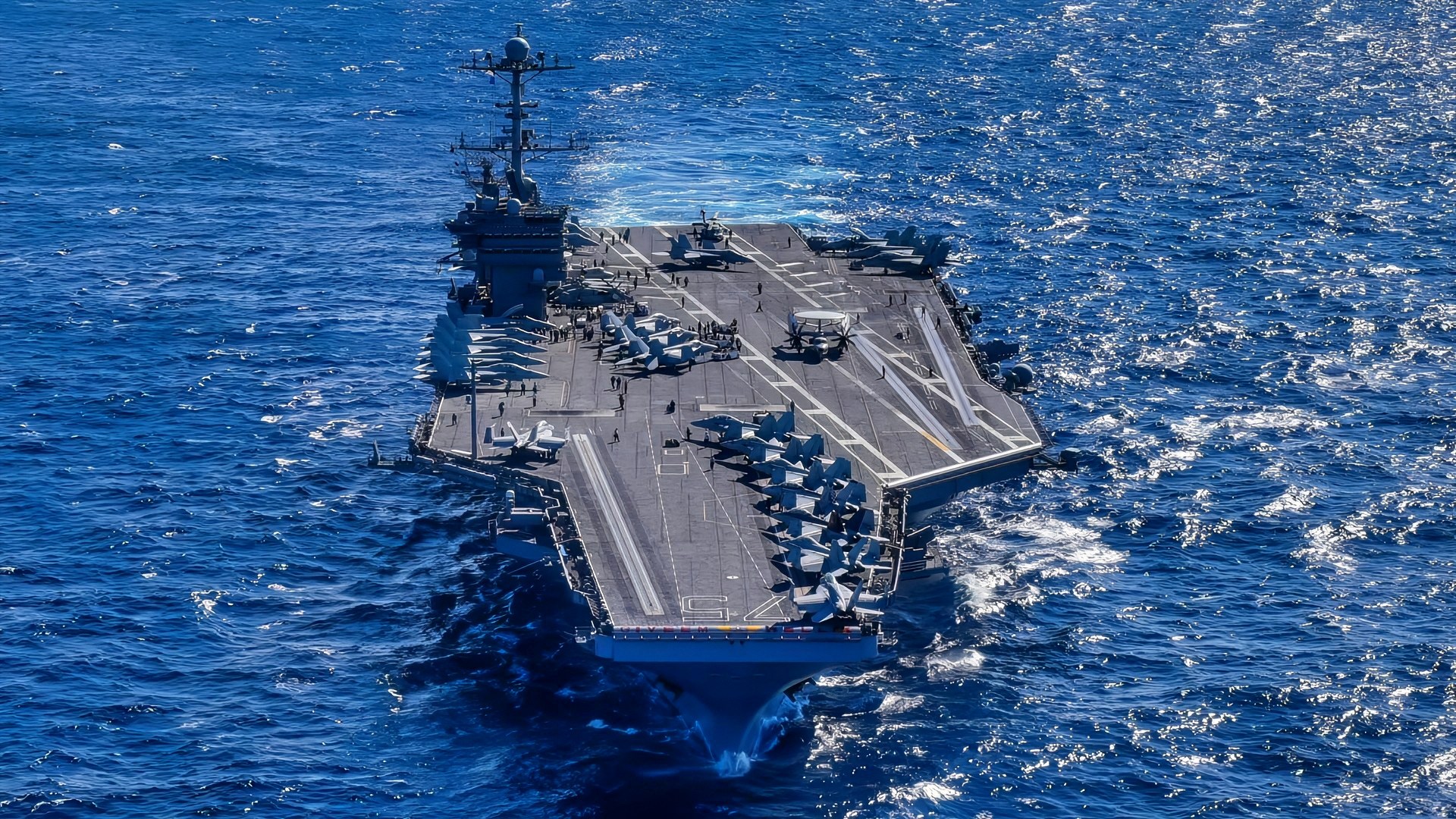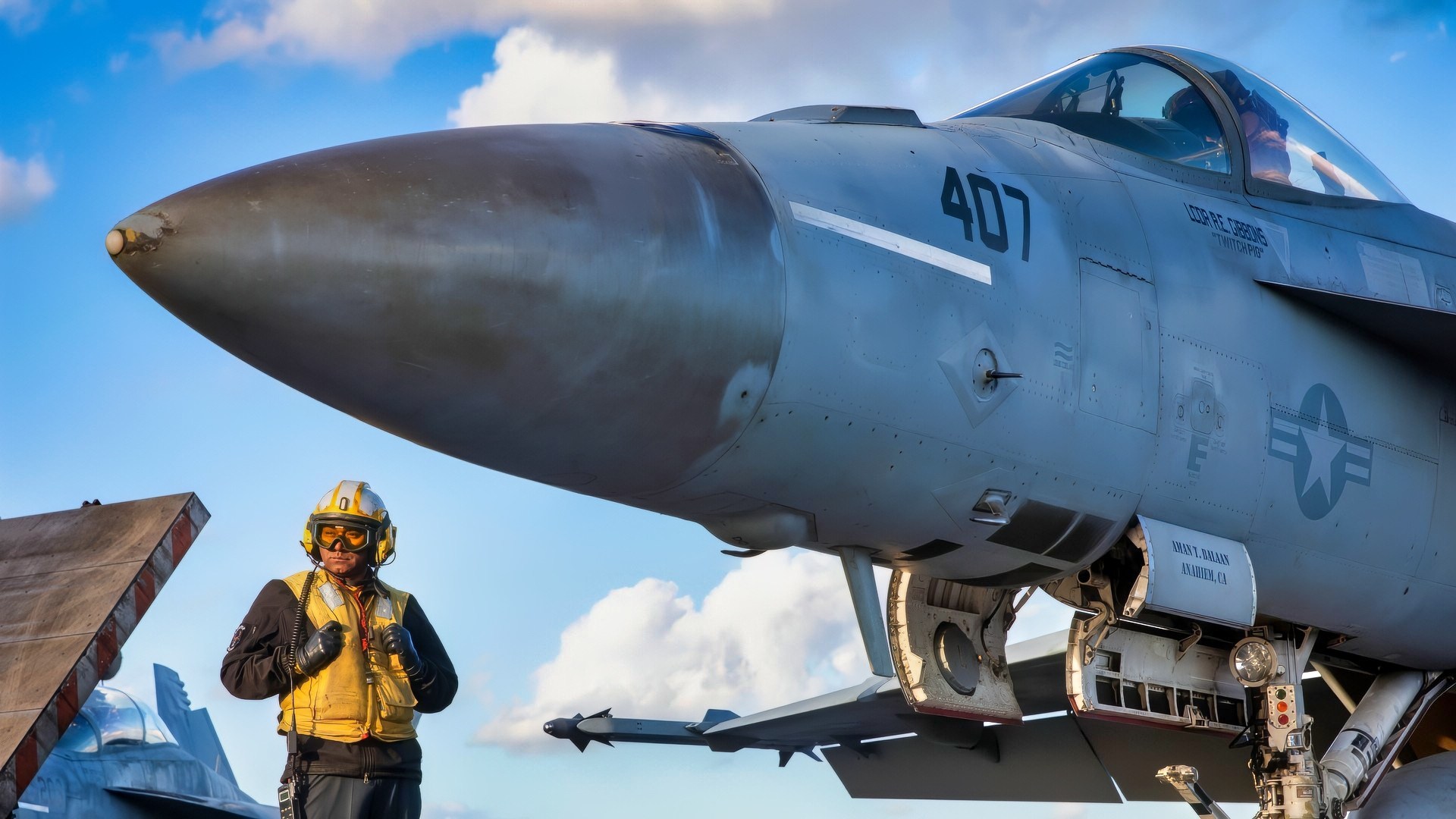Article Summary – In 2005, Swedish AIP submarine HMS Gotland stunned the U.S. Navy by repeatedly “killing” carrier USS Ronald Reagan in exercises, exposing how hard modern diesel boats are to find.
-Gotland’s Stirling air-independent propulsion let it stalk quietly for days, exploiting coastal waters and ASW skills dulled after the Cold War.

120710-N-RY232-571 MEDITERRANEAN SEA (July 10, 2012) – An SH-60F Seahawk from the Nightdippers of Helicopter Anti-Submarine Squadron (HS) 5 flies alongside Nimitz-class aircraft carrier USS Dwight D. Eisenhower (CVN 69), July 10. Dwight D. Eisenhower is on a regularly scheduled deployment in support of Maritime Security Operations (MSO) and Theater Security Cooperation (TSC) efforts in the U.S. 5th and 6th Fleet areas of responsibility. IKE deployed as part of Eisenhower Carrier Strike Group (CSG), which includes CSG 8, IKE, guided-missile cruiser USS Hue City (CG 66), guided-missile destroyer USS Farragut (DDG 99), guided-missile destroyer USS Winston S. Churchill (DDG 81), USS Jason Dunham (DDG 109), the seven squadrons of Carrier Air Wing (CVW) 7, and Destroyer Squadron 28. (U.S. Navy photo by Mass Communication Specialist 2nd Class Julia A. Casper/Released)
-The U.S. response—leasing Gotland for two years of training—reset tactics, sensors, and mindset for hunting quiet SSKs.
-The episode didn’t make carriers obsolete, but it did prove that air-independent submarines are a serious, global sea-denial threat that demands relentless, realistic antisubmarine warfare training. Those lessons still shape U.S. planning today.
How a $100 Million Swedish Sub ‘Sank’ a $6 Billion US Carrier
In 2005, a small, diesel-electric submarine from Sweden forced the most powerful navy on earth to rethink some very basic assumptions. During pre-deployment workups off Southern California, HMS Gotland reportedly penetrated the defensive screen of Aircraft Carrier Strike Group 7, lined up on USS Ronald Reagan, and registered multiple “kills” with exercise torpedoes before slipping away. No fireworks. No skyline of smoke. Just a periscope, a camera, and the cold arithmetic of probability.
As an editor and think tank researcher for several publications and institutions over the years, I was utterly shocked when I came across this story a decade ago.
The story has been told—and retold—for years. But when you strip away the internet lore, what remains is more interesting than a meme: a practical demonstration that air-independent propulsion (AIP) submarines in skilled hands can be maddeningly hard to find, and that the U.S. Navy, after a decade of post–Cold War ASW atrophy, needed reps against exactly that threat.
The Navy responded the right way—by leasing Gotland and her crew for two full years of sparring out of San Diego—because AIP boats were proliferating and the fleet needed hard lessons fast.
What follows is the deeper look: how Gotland pulled off its party trick, why AIP was so disruptive at the time, why the episode surprised the U.S. Navy, what the two-year lease accomplished, and why the lessons still matter in an era of distributed sensors, long-range anti-ship weapons, and crowded littorals.

171030-N-EA818-367 ATLANTIC OCEAN (Oct. 30, 2017) The aircraft carrier USS Harry S. Truman (CVN 75) transits the Atlantic Ocean. Harry S. Truman has successfully completed tailored shipboard test availability and final evaluation problem and is underway preparing for future operations. (U.S. Navy photo by Mass Communication Specialist 3rd Class Tommy Gooley/Released)
Why Gotland Was A Different Kind Of Quiet
If a nuclear submarine wins by endurance and speed, a modern AIP boat wins by silence at tactically useful endurance. Classic diesel-electrics are whisper-quiet on battery but must snorkel regularly to run diesels and recharge—noisy work that also makes them easier to detect.
Sweden’s Gotland-class changed the game in the mid-1990s by integrating Stirling-engine AIP, a closed-cycle external-combustion system fed by liquid oxygen that can generate electrical power while fully submerged. The payoff isn’t high speed; it’s days to weeks of low-speed, nearly vibration-free underwater operation without exposing a snorkel mast.
That matters because the underwater battlefield is run on probabilities. Every snorkel is a detection opportunity—by radar, infrared, electronic support measures, even visually. Every hour that a sub can loiter without snorkelling, hugging layers and bottom contours, is an hour the surface force must search a wider volume with fewer clues. Add in anechoic coatings, machinery isolation, and a propulsion line optimized for steady, low-RPM running, and you get the kind of acoustic profile that humbles even good passive sensors, especially in littoral water with mixed salinity, bottoms that scatter sound, and shipping noise that masks signatures.
Sweden designed for exactly that environment. The Baltic is a sonar engineer’s nightmare: shallow, busy, variable. The Gotland-class was optimized from first principles to be hard to hear there. Those design habits came with the boat to California.
How A Small Sub Stole A March On A Big Deck Aircraft Carrier
Exercises aren’t prize fights; they’re scripted to teach. But within the exercise’s rules, Gotland played its hand well. The “recipe” was textbook SSK tradecraft: pick an approach corridor the carrier must traverse, sit still and listen while the strike group creates its own acoustic clutter, exploit layer conditions, and move only in short, thought-out bursts. At very low speed on AIP, Gotland’s acoustic signature was so small that passive sensors had little to chew on; active sonars could search, but the Pacific’s coastal shallows and the need to protect the air wing’s tempo can limit how aggressively you ping.
The carrier’s screen, to be clear, is no slouch: destroyers and cruisers with towed arrays and variable-depth sonars, helicopters with dipping sonars, maritime patrol aircraft laying buoys, and—often—cooperating submarines. However, antisubmarine warfare is a team sport with time pressure. In 2005, the U.S. team had spent the better part of a decade focused on land wars and maritime security tasks, rather than stalking quiet littoral SSKs. When Gotland reached periscope depth inside the inner ring and clicked the shutter on aircraft carrier Ronald Reagan, the message landed: we need more at-bats against boats like this.

Aviation Boatswain’s Mate (Aircraft Handling) 1st Class Jose Mejiacastro, assigned to Air Department aboard the world’s largest aircraft carrier, USS Gerald R. Ford (CVN 78), prepares to signal to a Carrier Air Wing 8 F/A-18E Super Hornet attached to Strike Fighter Squadron 87 on the flight deck, Sept. 26, 2025. Gerald R. Ford, a first-in-class aircraft carrier and deployed flagship of Carrier Strike Group Twelve, is on a scheduled deployment in the U.S. 6th Fleet area of operations to support the warfighting effectiveness, lethality and readiness of U.S. Naval Forces Europe-Africa, and defend U.S., Allied and partner interests in the region. (U.S. Navy photo by Mass Communication Specialist 2nd Class Mariano Lopez)
The Shock Was Real—And So Was The Response
The Navy didn’t sulk. It wrote a check. In March 2005, the United States and Sweden signed a memorandum to base Gotland and her Swedish crew in San Diego for a year of bilateral training—an arrangement extended through 2007. The deployment, often referred to informally as the Swedish Submarine Deployment, turned the little AIP sub into a full-time sparring partner for aircraft carrier groups, destroyer squadrons, P-3C/P-8A crews, and MH-60R helicopter detachments rotating through workups on the West Coast.
The logic was simple: there is no classroom substitute for a live, modern AIP opponent. Gotland played OPFOR in composite training units, joint task force exercises, and bespoke ASW events, while U.S. crews iterated on tactics—sonobuoy patterns, multistatic active techniques, towed array employment in challenging bottoms, and the choreography of air-surface-submarine cueing. The submarine also forced relearning of basics: speed discipline in the screen, emissions control to deprive the sub of cueing, patient tracking over fast sweeping, and accepting the geometry that sometimes the only honest way to sanitize a lane is to put another submarine in it.
Sweden, for its part, gained a lot from the deal: experience in warm-water acoustics, a deep look at American ASW processes, and data to inform its next-generation designs. Both sides won.
What Made Gotland Special At The Time
AIP was the headline, but Gotland brought a holistic quieting package:
Stirling-Engine AIP: Closed-cycle power generation underwater with minimal vibration, supplying the batteries without snorkeling.
Battery-Dominant Tactics: Use AIP to keep the batteries topped and the boat submerged for days; use batteries tactically for sprints or ultra-quiet creeps.
Compact Hull With Smart Isolation: Swedish practice emphasized resiliently mounted machinery, careful shaft-line design, and shock isolation.

The Nimitz-class aircraft carrier USS Carl Vinson (CVN 70) arrives in Joint Base Pearl Harbor-Hickam, Hawaii, for a scheduled port visit, July 30, 2025. Vinson, the flagship of Carrier Strike Group ONE, is underway conducting routine operations in the U.S. 3rd Fleet area of operations. (U.S. Navy photo by Roann Gatdula)
Littoral Sensor Fit: A suite tuned for close-in work and target motion analysis in cluttered water, not just chasing open-ocean boomers.
A Mixed Torpedo Battery: Standard heavyweight 533-mm weapons paired with smaller 400-mm tubes give flexibility for different engagements and training.
None of this made Gotland “better” than a U.S. nuclear boat in an absolute sense. It made her disproportionately dangerous in cluttered water and painfully survivable in certain geometries—exactly the kind of geometry you get near choke points, straits, and coasts.
Aircraft Carrier Shocker: Why It Surprised The U.S. Navy
By 2005, the U.S. surface force and air wing hadn’t had enough live reps against truly quiet SSKs. The end of the Cold War and a long focus on land campaigns meant ASW funding, manning, and training intensity declined. Many Cold War tools (e.g., some towed arrays and low-frequency active systems) aged out or were spread thin; expertise concentrated in pockets. AIP boats, meanwhile, were proliferating: Germany’s Type 212/214 families, Sweden’s exports, Japan’s Stirling-equipped boats (and later lithium-ion designs), South Korea’s programs—navies around the world were fielding SSKs with week-long submerged endurance and soft acoustic edges.
Gotland was, in that sense, both a wake-up call and a gift. It surfaced—pun intended—a training gap and then stuck around to help close it.
The Exercises Were Real—And So Were The Constraints
Exercises impose rules. OPFOR subs often get mission tasking with the benefit of hindsight: they know roughly where and when the high-value unit must pass; their job is to stress the screen and expose seams. Carrier strike groups often work under constraints (air-plan tempo, training objectives) that complicate pure ASW focus. And “sinking” a carrier in an exercise means achieving a firing solution and recording evidence; in a war, that final run to weapon release might be the most dangerous minute of a sub’s life.
All true—and none of it erases the core lesson. If conditions that are common in the real world (busy water, time pressure, imperfect cueing) let a high-end AIP boat routinely get inside the screen, the fleet has work to do. That was the point of keeping Gotland in San Diego for two years.
What The Navy Changed After Two Years With Gotland
Some of the response was hardware: refreshed towed arrays and variable-depth sonars for surface combatants; a sharpened transition from P-3C Orion to P-8A Poseidon with multistatic sonobuoys; acceleration of the MH-60R’s full ASW kit; investment in multistatic active tactics that use separate source and receiver buoys to light up quiet targets; and renewed enthusiasm for putting U.S. submarines into the sub-hunter role in carrier workups. Training syllabi were surely updated; doctrine and playbooks were likely rewritten with AIP-specific considerations in mind.

PACIFIC OCEAN (Aug. 11, 2025) – U.S. Navy Sailors direct an E/A-18G Growler, assigned to the “Vikings” of Electronic Attack Squadron (VAQ) 129, on the flight deck of the Nimitz-class aircraft carrier USS Theodore Roosevelt (CVN 71), Aug. 11, 2025. Theodore Roosevelt, flagship of Carrier Strike Group (CSG) 9, is underway conducting exercises to bolster strike group readiness and capability in the U.S. 3rd Fleet area of operations. (U.S. Navy photo by Mass Communication Specialist Seaman Apprentice Cesar Nungaray)
Equally important was mindset. Crews relearned to think like the quiet adversary: stay patient, assume the SSK has more time than you do, and refuse to be rushed into noisy, high-speed searches that help the submarine more than the screen. Commanders revisited emissions control, de-cluttering the acoustic environment and denying the sub free cueing. And the Navy built more live sparring into its calendar—through continued bilateral work with foreign SSKs and the long-running Diesel-Electric Submarine Initiative (DESI) with partner navies.
Why AIP Proliferation Still Changes The Math
The global trend that made Gotland a useful sparring partner has only accelerated. Many navies now field AIP or near-AIP endurance SSKs, some with lithium-ion batteries that transform the sprint-and-drift tradeoffs, others with mature Stirling or fuel-cell plants. They are cheap compared to nuclear boats, can be built or bought in small numbers by regional navies, and are tailor-made for sea denial in straits, archipelagos, and coastal bastions. Against a high-value force that must operate near land to put aircraft in range—or to force contested sea lanes—those SSKs offer an adversary the chance to trade time for position.
The U.S. answer isn’t to panic about aircraft carriers; it’s to layer defenses and distribute risk—push the air wing’s reach (tankers, long-range weapons), fill gaps with manned and unmanned ASW platforms, and keep expanding the fleet’s acoustic picture with fixed and mobile arrays. The Gotland episode didn’t say “carriers are obsolete.” It said “carriers must be escorted by a navy that trains, equips, and fights as if quiet SSKs are everywhere.”
What Gotland Meant For Sweden
For Sweden, Gotland’s American tour was a validation at scale. The boat’s AIP philosophy—born in the Baltic—proved relevant in blue-water training against the biggest fleet afloat. The data and experience fed directly into modernization of the Gotland-class and into the design of Sweden’s next-generation A26 (Blekinge) class, which doubles down on stealth, modular payload options, and long endurance without snorkeling. It also cemented Sweden’s reputation as a thinking person’s submarine builder: small boats, smartly engineered, optimized for the water they fight in.
Aircraft Carrier Myth, Memory, And The Message That Endures
Did a $100-million diesel boat really “sink” a $6-billion carrier? In the construct of an exercise, yes. Does that mean a single SSK would inevitably kill a U.S. supercarrier in war? No. It means what the Navy took it to mean in 2005: don’t underestimate quiet, patient adversaries; don’t let ASW proficiency atrophy; and fight the fleet you’re up against, not the one you prefer.
That’s the legacy of Gotland’s two years in San Diego. The little sub from the Baltic didn’t change the Navy’s center of gravity overnight. It did something quieter and more durable: it helped the fleet remember that silence is a capability—and that the surest way to beat it is to train against it, relentlessly.
About the Author: Harry J. Kazianis
Harry J. Kazianis (@Grecianformula) is Editor-In-Chief and President of National Security Journal. He was the former Senior Director of National Security Affairs at the Center for the National Interest (CFTNI), a foreign policy think tank founded by Richard Nixon based in Washington, DC. Harry has over a decade of experience in think tanks and national security publishing. His ideas have been published in the NY Times, The Washington Post, The Wall Street Journal, CNN, and many other outlets worldwide. He has held positions at CSIS, the Heritage Foundation, the University of Nottingham, and several other institutions related to national security research and studies. He is the former Executive Editor of the National Interest and the Diplomat. He holds a Master’s degree focusing on international affairs from Harvard University.











John Kociuba
October 7, 2025 at 8:44 am
Please clear the room of all dogma and sophism. The “Lawyers” and corrupt “Military Brass” built the Chinese war machine. Is anyone going to take responsibility or keep cashing checks until all public treasure has been depleted? The Founding Fathers called it TREASON! They hung men & women in the public square for all to see. What you fail to realize is the lack of execution in domicile National Security and International Policy. The United States will NEVER get it’s integrity back from the undecided. Those videos of a grotesque man dressed as a women with 4 military stars will be played for centuries to come along with propaganda that United States is on borrowed time, and they’re correct.
Ou812
October 7, 2025 at 12:08 pm
You got a big mouth
Edward R Brennan
October 7, 2025 at 2:21 pm
20 year old story told way too many times
Gary Crites
October 7, 2025 at 2:27 pm
This has nothing to do with National Security. A friend of mine who was, is, a Marine quietly passed away. She was a cryptologist in 1940. She could decipher code from the enemy communication. We fill the cemeteries, husbands, wives, sons, daughters giving our lives to protect as you call our home land. Why do you hurt my brothers and sister of all walks of life upon this land…..we love our home land. As you say Make America Great Again……I say Make America Godly Again. Love me before l am gone. Bury my remains with the stars, away from my home land,love me from afar as l am not loved here. You see me in day as in night,the brightest star. There is where l won’t to rest.l want to give you the moon. In God We Trust.
Quietly, The unknown Soldier.
David
October 7, 2025 at 4:27 pm
Just build us a friggin’ car that won’t break down or cost 1000’s of dollars in upkeep just to keep it roadworthy & make it somewhat affordable…do you think you can handle THAT!?! The current pieces of crud on tha road ain’t it, they should be giving them away for free & we could then just pay for the upkeep repairs & maintenance!! That would be more reasonable at least…
Darrel
October 7, 2025 at 7:23 pm
Why are all the comments a bunch of obnoxious complainers??
Pete
October 7, 2025 at 7:54 pm
What the author failed to mention is the Commanding Officer of this submarine was a woman.
Francisco Gancedo
October 8, 2025 at 1:55 pm
This was outlined in a Clancy book. If you can sit on the bottom and rise in between the group. They could never stop you in time at that range.
Jason
October 9, 2025 at 4:23 pm
These exercises aren’t accurate at all. I was a helicopter acoustic sensor operator and we arent allowed to use our sensors to the full potential. The water creates sound layers and we need our sensors in the correct layer. Can’t do that when the exercise rules say we can’t put our transducer below 90ft so we don’t risk hitting the sub. Oh, and you have to stay on low power for active sonar, which is a 10th of the power of full power.
Mario
October 9, 2025 at 10:17 pm
What had no one ever seen captain Ron???
Fgibbs
October 10, 2025 at 4:00 pm
This is old news, reported every 60 days or so. Don’t they have anything new to say? The incident occurred in 2005, what is not stated in the article is What exactly the war game was testing, what exactly was the condition on the U.S. Navy, what were the base assumptions. If you don’t know that, you really don’t know if this was a realistic test of anything.
Robert Howard Cone
October 11, 2025 at 11:19 am
Yes, as a former US guppy class submarine sailor with a couple or Westpac cruises during Vietnam.
Bagging Carriers was a normal occurrence
Tom Sheridan
October 11, 2025 at 11:45 am
Failed to mention the Swedish commander is a woman is hopefully an indication that it is skill and competence that is promoted.
I appreciate the article and the authors well arranged insight to the subject.
Chaz
October 11, 2025 at 2:19 pm
Little bank take big bank
Joseph K
October 12, 2025 at 12:14 am
What a bunch of whiny DF MAGA more ons. MAGA stands for Make America Gay Again or Make Allah Great Again. Take your pick.
Moving right along. First of all everyone knows that the yanks are afraid of China not just because they’re a nuclear superpower but they know that China could easily spam cheap missiles worth a few thousand a piece to destroy entire carrier strike groups. That’s why the yanks have been begging NATO to back them up. But NATO countries still have horrific flash backs of China defeating 26 countries led by none other than the US during the Korean war. Hoopla, we still have North Korea.
Hermann S
October 12, 2025 at 5:20 am
Isn’t that the premise of Down Periscope?
Lee
October 13, 2025 at 8:46 am
That’s incorrect reporting. When you see articles about ship sunk or plane went down its usually money arraignments between countries on some piece of military equipment. See Kim Gougen United Network News GIA reports for truth. Thanks